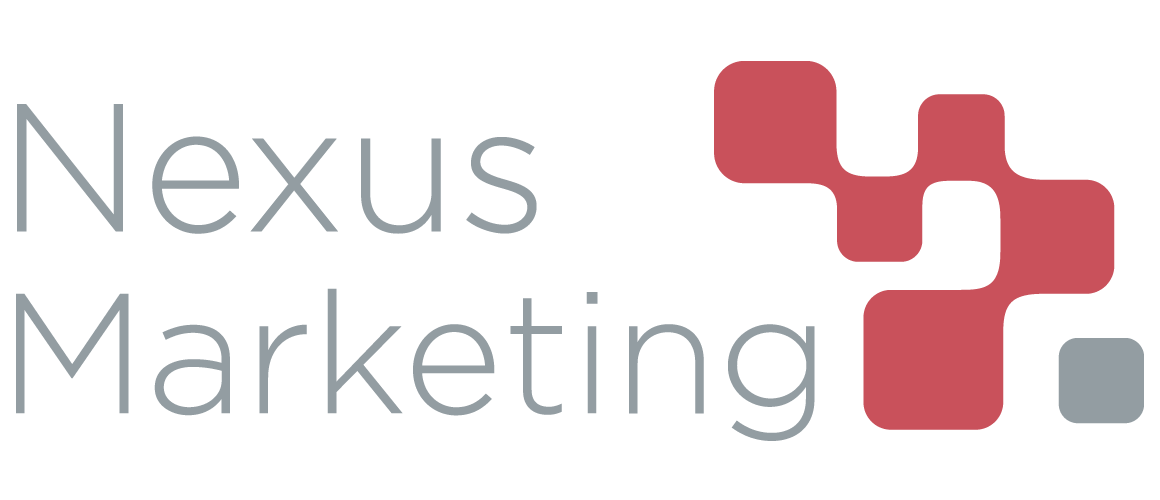Cookieless Tracking, Google Analytics 4, and What It All Means for You
The ways that websites collect visitor data is changing fast. The biggest player in the space, Google, is finally catching up.
To stay compliant with evolving privacy regulations and to keep drawing reliable insights from your website’s performance (like the ROI of your SEO investments), you need to understand these changes. Specifically, you need to understand Consent Mode and its predictive modeling features in Google Analytics 4.
Here’s a quick guide to third-party cookie deprecation, “cookieless tracking,” and what they mean for your marketing analytics:
- Quick Context
- Privacy Regulations and Cookies
- Privacy and Google Analytics 4
- What is Consent Mode?
- How to Activate Consent Mode and Behavioral Modeling
- Next Steps
Quick disclaimer: We’re not tech or legal experts, we’re digital marketers.
This is our quick summary of changes in the digital privacy landscape and their implications on digital marketing. Please consult with a specialized professional if you have questions about your site’s compliance or backend consent management practices.
(But for questions about digital marketing, SEO, and tracking your lead generation results, we can definitely help.)
Quick Context
Here’s the background:
- Laws like the GDPR and state-level regulations in the United States require websites to ask for user consent before using any cookies not deemed “necessary.”
- It’s not often possible to ask for consent to use third-party cookies, so these are effectively banned (or at least made very difficult to use) under many of these laws.
- Google (whose Chrome browser dominates the market) has been relatively slow to adapt but will finally deprecate third-party cookies sometime in 2025.
- Consent Mode is now mandatory for all websites that use Google Analytics and/or Google Ads, but you’re likely already in compliance—see our breakdown and instructions below.
Let’s say you understand the laws and your website actively asks for consent to use cookies. Everything seems to be running fine.
So what’s the issue?
There are two key areas where your brand could take a hit as a result of changing cookie practices: first-party data collection and advertising.
Impacts on First-Party Data Collection
Google Analytics uses first-party cookies to track engagement data of visitors on your website. These cookies are not considered “necessary” and thus require consent.
When users decline or ignore consent requests, this results in gaps in your data—potentially huge blank spaces in your digital marketing analytics.
You’ve likely already seen some of these effects as consent collection becomes the norm and as Google Analytics 4 has rolled out new compliance features and tools.
Without reliable data about how users are finding, engaging with, and leaving your website, your marketing strategy will suffer. Understanding user journeys and conversions is critical for improving over time, and this data is essential for measuring the ROI of your marketing strategies like SEO campaigns.
This is why this issue is top of mind for us here at Nexus Marketing. As the web evolves, we want our clients and partners to help lead the charge.
Impacts on Online Advertising
For brands that rely heavily on online advertising, particularly retargeting campaigns, the deprecation of third-party cookies on Google’s Chrome will be a major change.
As they currently work, these campaigns will be practically impossible without third-party cookies.
Many brands are still running late. An Adform survey found that:
- 65% percent of U.S. respondents reported already seeing a negative impact on their online advertising efforts as a result of third-party cookies being blocked on many browsers.
- Nearly 40% are not fully aware of the solutions available to navigate this change.
- 36% don’t have a clear idea of how third-party cookie deprecation will impact their marketing strategies.
Why It Matters
Cookie deprecation is already underway, and it’ll continue to be a major discussion in the coming months as Google moves ahead with its planned changes. You need a strategy for shifting your advertising and first-party data collection methods now.
Thankfully, Google appears to be on top of it. For advertising, Google has been developing new alternatives to third-party cookies. For data collection, GA4 has introduced new features that help fill data gaps.
As SEO marketers, our main focus is on first-party data collection.
We’ll take a closer look at GA4’s solution, behavioral modeling in Consent Mode, below—jump ahead to check it out.
And if you’ve already implemented Consent Mode, we’ll also discuss warning signs to look for that may indicate data isn’t flowing correctly.
Digital Privacy Regulations & Cookies
Here’s extra context that you may find helpful:
Why do cookies require consent?
Since the adoption of the GDPR and ePrivacy Directive in the EU, third-party cookies have been effectively banned for use on site visits from European visitors. Similar laws from the U.S. and around the world have since been enacted, too.
Even though not all of a site’s users will come from these jurisdictions, the laws are widespread enough today that it’s essentially easier to treat them as universal than it is to spend time and resources completely fine-tuning the site’s backend for different visitors.
This is why sites today expressly ask for user consent to use cookies. (Learn more about cookies here.)
Many of the big web players adapted fairly quickly. Web browsers like Safari and Firefox made fast changes to comply with the new norm. Apple has made frequent updates to the privacy features of iOS to stay in compliance, as well.
The effect has been that it’s now difficult for websites to track user behaviors on these browsers and systems for the purpose of retargeting them with ads.
Why has Google been slow to adapt?
Google implemented a solution in GA4 for mitigating the impacts of cookie consent, Consent Mode, back in 2020.
Since 2020, Google has also announced and postponed third-party cookie deprecation several times. The delays now appear to be coming to an end, with the current deadline sometime in 2025.
Why the delays? Google generates a lot of its revenue from advertising tools and services.
Third-party cookie deprecation directly limits their ability to operate, so Google has been working to develop alternative systems that will protect these revenue streams through its ambitious Privacy Sandbox initiative. With the 2025 phaseout period fast approaching, it seems like Google might finally be ready.
What’s the difference between first-party and third-party cookies?
- First-party cookies are set by the site currently being visited. They operate for single sessions and then deactivate when a user leaves that website.
- Third-party cookies are set by a visited website or embedded element that a user encounters but persist as the user visits other websites, tracking their behavior across the web.
Both types of cookies can serve a variety of purposes. For example, cookies are useful for remembering a user’s preferences. A first-party cookie will log this preference data in discrete events rather than as a longer flow of behaviors across multiple sites, as would a third-party cookie.
The biggest use case of third-party cookies by far is to glean insights from a user’s behavior across the web in order to target them with advertising and tailored content later.
Websites use Consent Management Platforms to ask for user consent, track consent collection, and implement the appropriate (or no) cookies as needed. This tool is essential for relaying users’ consent to Google Analytics.
Are third-party cookies illegal?
No, they’re not. But collecting user data without consent is illegal under the regulations discussed above.
In effect, then, most third-party cookies have been made useless (at least for websites that care about compliance).
Remember, too, that the regulatory landscape is constantly changing.
New, complex legislation spurs changes to the web browsers and systems that the whole world uses every day. These big changes filter down into the smaller tools that websites use to measure their traffic and engagement. As the landscape evolves, we can always expect to encounter broken code, malfunctioning website plugins, and more.
This is one of our key takeaways:
Stay aware and be intentional about what you install on your website and whether it’s working properly.
Here we should note that the term “cookieless tracking” is a bit of a misnomer.
Third-party cookies are being phased out on Google Chrome in 2025. Older methods of tracking web analytics relied on them heavily, so the scope of this change in recent years has been quite significant.
First-party cookies aren’t going anywhere. They’ll still be essential for understanding how users engage with your website, but the constantly changing privacy landscape and platform updates mean that they’ll be used in new and increasingly constrained ways.
In fact, these regulatory changes and the third-party cookie phase-out are what spurred the creation of the newest version of Google’s web analytics platform.
Privacy and Google Analytics 4
The shift from Universal Analytics (UA, the legacy version of the platform) to Google Analytics 4 (the newest version) is now complete. As of July 2024, all historical data stored in Universal Analytics properties is now unavailable.
GA4 is a robust platform. This upgrade from UA to GA4 introduced many up-to-date consent compliance features.
What’s the key difference between UA and GA4?
The core difference between these platforms is how their data models group incoming engagement data.
- Universal Analytics used a session-based model that grouped all user actions under discrete visit sessions, and it relied heavily on cookies.
- Google Analytics 4 uses an event-based model, more closely tracking each user interaction as separate events. It’s a more user-centric and less cookie-dependent system.
We won’t get too in the weeds, but the key takeaway is that GA4 allows for a much more granular and customizable understanding of how visitors are engaging with your website.
(If you’re curious, this article details the technical differences between the platforms in greater detail.)
Privacy features are integral to GA4.
The event-based structure of GA4 allows it to collect first-party data more seamlessly and in new ways that reduce privacy concerns.
It’s possible to collect user engagement data on GA4 without using third-party cookies or collecting IP addresses. This is done through first-party cookies. When users decline consent requests, these data gaps are filled using GA4’s Consent Mode.
What is Consent Mode?
Consent Mode is a feature that you can enable in your GA4 properties that ensures your tracking mechanisms properly adapt to user preferences. Google describes it as a tool that allows websites to collect data on website conversions while fully respecting users’ consent settings.
When Consent Mode is enabled, you’re then able to turn on a “behavioral modeling” feature that works to fill in the blanks in your analytics data through machine learning.
In a nutshell, here’s how it works:
(Source: Cookieinformation.com)
- A user provides or rejects cookie consent when they arrive on your site.
- Consent Mode communicates the user’s choice to the data collection mechanism installed in the site.
- Data is collected and transmitted to GA4 according to the user’s choice. Session start data gathered via first-party cookies from users who rejected consent is completely anonymized and/or highly limited in other ways.
- The Consent Mode tool then uses AI-powered predictive modeling to fill in the gaps for users who rejected consent.
This process is driven by machine learning. Although it’s still a relatively new technology and will keep evolving, it’s extremely helpful and gives us something much closer to the full data picture.
Learn more about Consent Mode with this list of FAQs.
Is Consent Mode mandatory?
Yes. As of March 2024, Consent Mode is now mandatory for all websites that use Google Analytics and/or Google Ads.
Note: Your website most likely already uses a consent management platform (CMP) to run its cookie banners and manage consent settings. If your CMP is Google-certified (most leading providers are), you’re all set. You should already have Consent Mode enabled in your GA4 properties.
If you do not use a CMP and instead have custom-coded consent banners and settings, you must manually enable Consent Mode. We’ll discuss how below.
Without Consent Mode, you risk noncompliance with key European and other regulations. Not enabling Consent Mode will also make collecting data for users in many jurisdictions around the world and/or who reject cookie consent essentially impossible. The data that you would collect would be incomplete and give you a warped view of events, engagement, and conversions on your website.
But by enabling Consent Mode, you’ll stay compliant and be able to use helpful GA4 features that fill in gaps in your analytics.
How to Implement Consent Mode and Behavioral Modeling
Let’s dive into the details about exactly how to ensure these features are enabled in your GA4 properties. First, some important clarification:
- Consent Mode ensures your website respects users’ privacy choices.
- Consent Mode also allows you to collect enough aggregated, anonymized session data so that Google can predict and model conversions from unattributed sources, called Conversion Modeling.
- GA4’s Behavioral Modeling feature works to fill in the rest of the gaps in your web analytics, but there are eligibility requirements your site must meet first.
We’ll take a look at each of these elements below.
Enabling Consent Mode
There are two ways Consent Mode can be enabled on your website depending on how you currently manage user consent preferences.
- If you use a Google-certified Consent Management Platform (CMP) to run your cookie consent banners, you should be able to easily turn on Consent Mode within your CMP’s features and options. This will handle the whole technical process of updating the GA4 tags that are triggered by site visits. Now that Consent Mode is mandatory, this setting is most likely already selected in your CMP, but double-check if you’re unsure.
- If you use a custom or hard-coded cookie consent banner, you’ll need to make these changes manually.
If you take the manual route, here’s what you’ll need to know:
First, you need to establish a default consent state for when users first arrive on your website. The default should be consent denial. Within your site’s code, add a script that establishes these defaults before the main Google Tag Manager script begins.
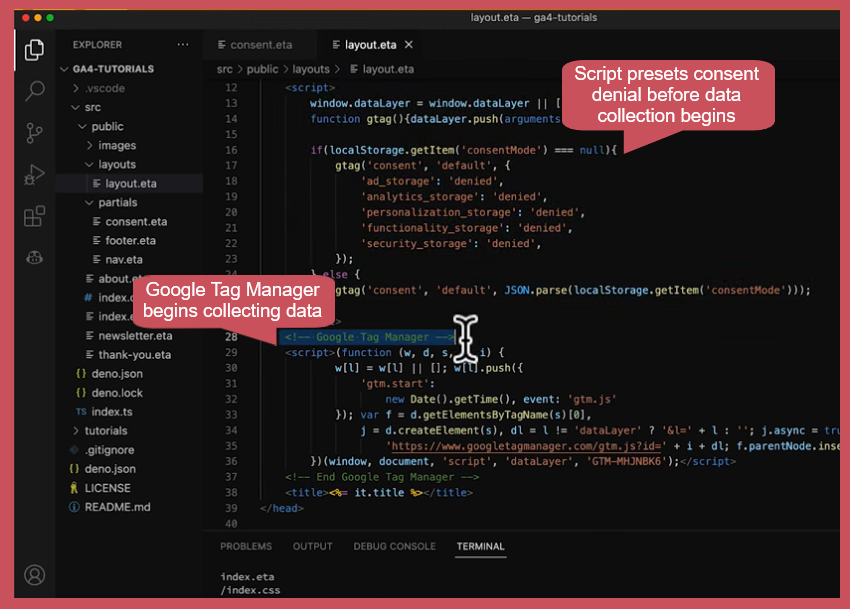
Next, update your hard-coded cookie consent banner to communicate user choices (and effectively override the default settings) by adding a new script:
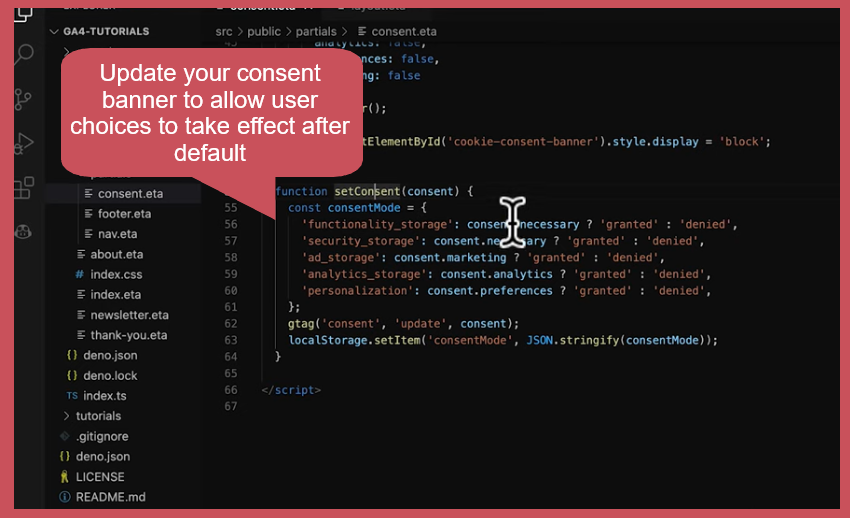
From here, navigate to your Google Tag Manager. You’ll need to enable “Consent Overview” to ensure that GA4 picks up on the changes you’ve made manually and so that you can further customize the consent settings for tags if needed.
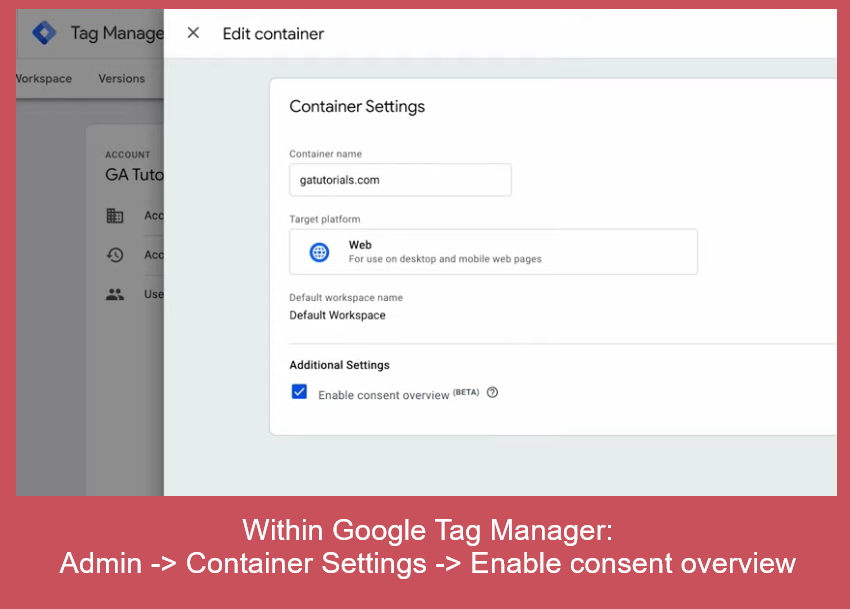
Here’s Google’s technical guide to implementing these coded changes. This video overview also explains the steps in greater detail if you’re curious:
Remember: In most cases, websites already use Google-certified Consent Management Platforms and will not need to handle these steps manually. Double-check what tool your website uses if you’re unsure.
If you do already use a CMP, explore its settings or reach out to its support team to confirm that Consent Mode has been activated for your properties.
Understanding Conversion Modeling
When Consent Mode is activated and running smoothly, your GA4 instance should be able to automatically model conversion data to help fill in data gaps.
Why is this necessary?
If a user declines consent but ultimately converts on your website (defined in GA4 as triggering a “Key Event”), their initial source will be reported only as “Direct.” They’ll be added to a bucket of unattributed conversions. This isn’t terribly helpful for understanding your website’s marketing performance.
Conversion modeling brings back attribution by mixing machine learning and observable data (either consented or highly limited, anonymized session start data). This diagram explains the value of Conversion Modeling:
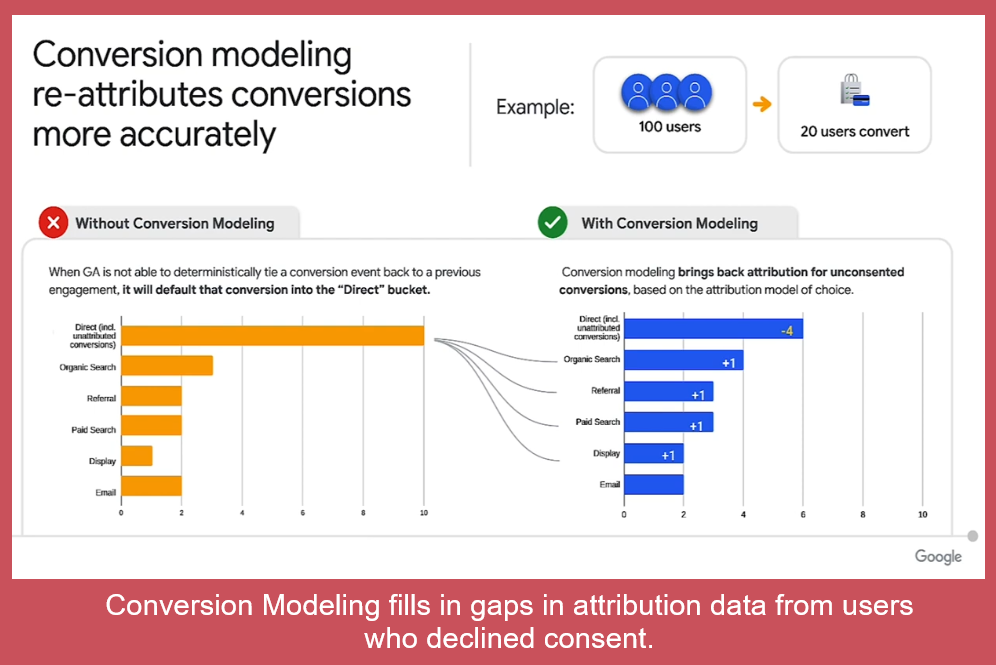
In this example, 20 users out of 100 converted. Without conversion modeling, the 10 of those users who declined consent are reported in GA4 as coming from a Direct source. Conversion modeling uses a mix of data to resort those users’ sources more accurately.
For marketers, conversion modeling is arguably the most important of GA4’s new AI- and privacy-related features to understand.
Conversion modeling should also occur in your GA4 properties automatically once Consent Mode is enabled. You don’t need to manually enable it.
However, know that you’ll gain the most useful insights from this feature if your website if your website generates enough conversions to provide Google with enough data to make predictions:
At least 300 conversions per month across the entire website (and for Google ads, 700 ad clicks over 7 days for a domain per country) is a rough rule-of-thumb to ensure full functionality and helpfulness.
Here’s a helpful guide to conversion modeling if you want to learn more.
Behavioral Modeling in Consent Mode
For many websites, GA4 offers an additional feature that fills in gaps in your analytics: behavioral modeling.
This feature pulls from observable data and predictive, AI-driven insights to help you estimate the exact events and interactions that occur across your website.
It’s important to note first that not all websites can use behavioral modeling through Consent Mode. Google lays out these eligibility requirements:
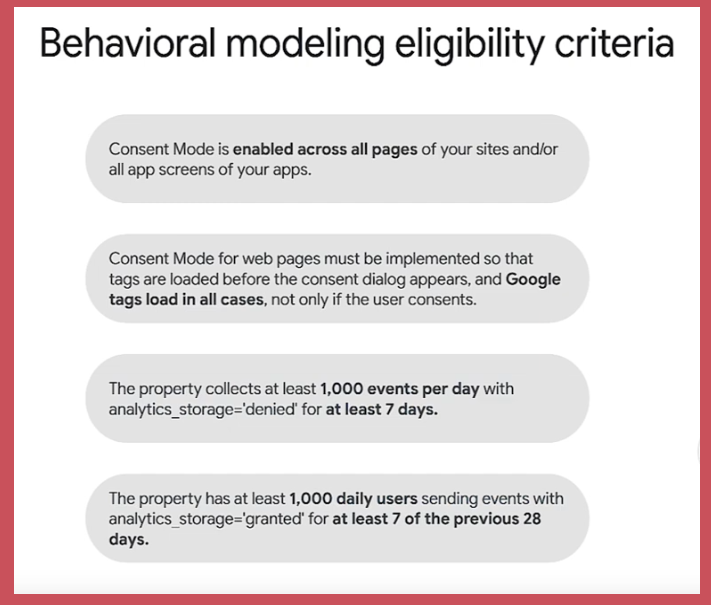
- Consent Mode is enabled. Again, if you use a CMP, this should already be done.
- Consent Mode is implemented so that default consent settings and other tag settings load before the Google tags themselves are triggered. See our explanation of where to code this script and the video overview above to learn more. This step ensures that you won’t begin collecting data until consent is secured.
- The website collects at least 1,000 unconsented events per day for at least 7 days. Note that “events” in GA4 can mean many things, but this does require you to receive at least 1,000 visits a week.
- The website also has at least 1,000 daily users triggered consented events for at least 7 out of the previous 28 days.
Why does Google set these requirements? For the behavioral modeling system to work correctly, it needs enough data to learn from. Without enough input data from both consented and unconsented users, the system is unable to make meaningful predictions.
If your website meets these requirements, great! We’ll explain below how to ensure behavioral modeling is enabled in your GA4 properties.
If your website does not meet these requirements, don’t worry. Of everything discussed in this guide, Consent Mode and conversion modeling are the most important for 1) ensuring compliance and 2) learning about your big-picture marketing performance. Behavioral modeling provides a more granular look at specific interactions on your website, but unless you have highly robust digital marketing practices, you likely won’t be missing much or any data that you would have previously used.
Remember that conversions are what create ROI for your marketing efforts, not smaller events.
Enabling Behavioral Modeling
Here’s a quick explanation of the implementation process for behavioral modeling:
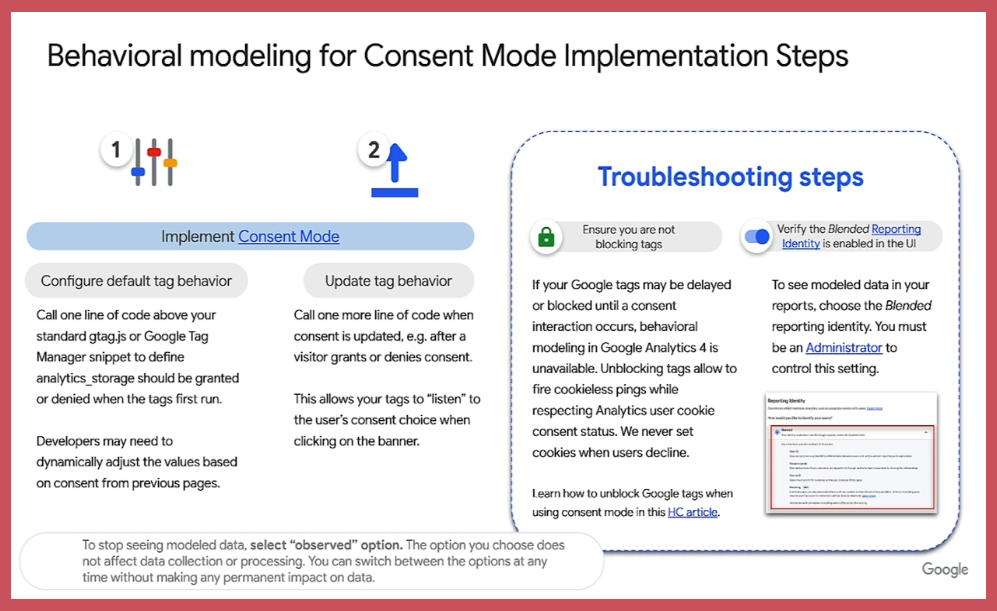
Items to note in this explainer:
- Default consent tag behaviors must be configured. (See above for our explanation of what this means and how to do it.)
- Your website must actively adapt to user preferences and override the default consent setting if needed. (See above for our explanation.)
- Your Google tags must be operational and not blocked, even for unconsented users. When Consent Mode is configured correctly, users who do not consent will still trigger cookieless pings (highly limited and/or anonymized session start data). The behavioral modeling system needs this information in order to work properly.
- “Blended Reporting Identity” must be selected within your GA4 property’s settings.
That’s it—turning on behavioral modeling is a simple process with only one manual step for most websites. Here’s where to turn on the correct reporting option for that last step:
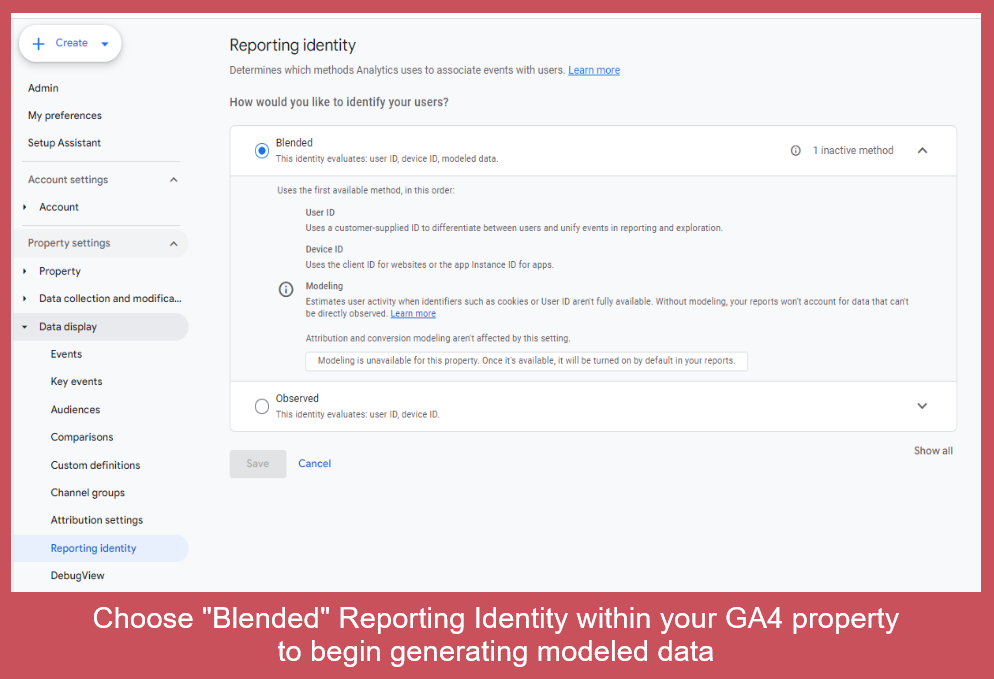
Setting your property’s reporting identity to “blended” tells Google to activate the behavioral modeling system and begin incorporated predicted data into your analytics reports.
Want a closer look at how GA4’s modeling systems work and how to enable behavioral modeling? Here’s an overview from Google:
Next Steps
- Double-check that Consent Mode has been enabled in your GA4 properties.
- If you use a consent management platform, this should have already happened.
- If you use a custom consent solution, you may need to do this manually.
- Enable behavioral modeling for your GA4 properties if eligible.
- Do this by choosing “blended” reporting identity in your property’s settings.
- Be intentional about the plugins and tools you install on your website.
- Stay aware of whether they’re working properly. With the internet privacy landscape changing so rapidly, broken functionalities and potential compliance lapses can happen.
- Think about how you can collect more consented, first-party data.
- How intentionally have you phrased your cookie consent banner?
- How can you better build relationships with customers so that they’ll be willing to provide consent and/or create accounts on your website and become repeat visitors?
- Building trust and a reputable brand is increasingly important, and it ties together a lot of what we’re seeing in the SEO world, too.
For Nexus Marketing clients, contact your Account Manager if you have any questions about this guide, your GA4 properties, and whether Consent Mode is activated for them. We can help you check and determine the appropriate next steps.
If You’ve Already Implemented Consent Mode
We mentioned above that broken functionalities are to be expected in the coming months and years. Some websites are already seeing issues with traffic attribution as Google fine-tunes its approach to privacy regulation adherence.
Depending on the mix of tools installed on your site and your GA4 settings, your data reporting not be working properly.
How can you tell? Here are a few signs that something isn’t working:
- Sharp changes in one or more traffic channels
- Mismatched trends between GA4 and your site’s click performance in Search Console
- Unexpected increases in Unassigned or Direct traffic to your website
- Disappearing web traffic for all or part of your site, or dramatic unexplained drops in traffic
Now may be the right time to quickly double-check your GA4 properties to look for any strange patterns or traffic drops.
Once they’re identified, the process of troubleshooting and correcting them shouldn’t be too difficult.
Nexus clients: Please contact your Account Manager if you encounter any of these issues or want help double-checking your GA4 properties.
This is a rich (and complicated) topic that won’t be going away anytime soon, so we encourage you to keep learning about third-party cookie deprecation, cookieless tracking, and GA4. Here are a few resources that we’ve found helpful:
- How Google Analytics 4 Uses Cookies to Track Visitors
- Top 10 Questions About Google’s Consent Mode v2
- Guide to Navigating Cookieless Tracking in Google Analytics 4
- What Is Conversion Modeling?
